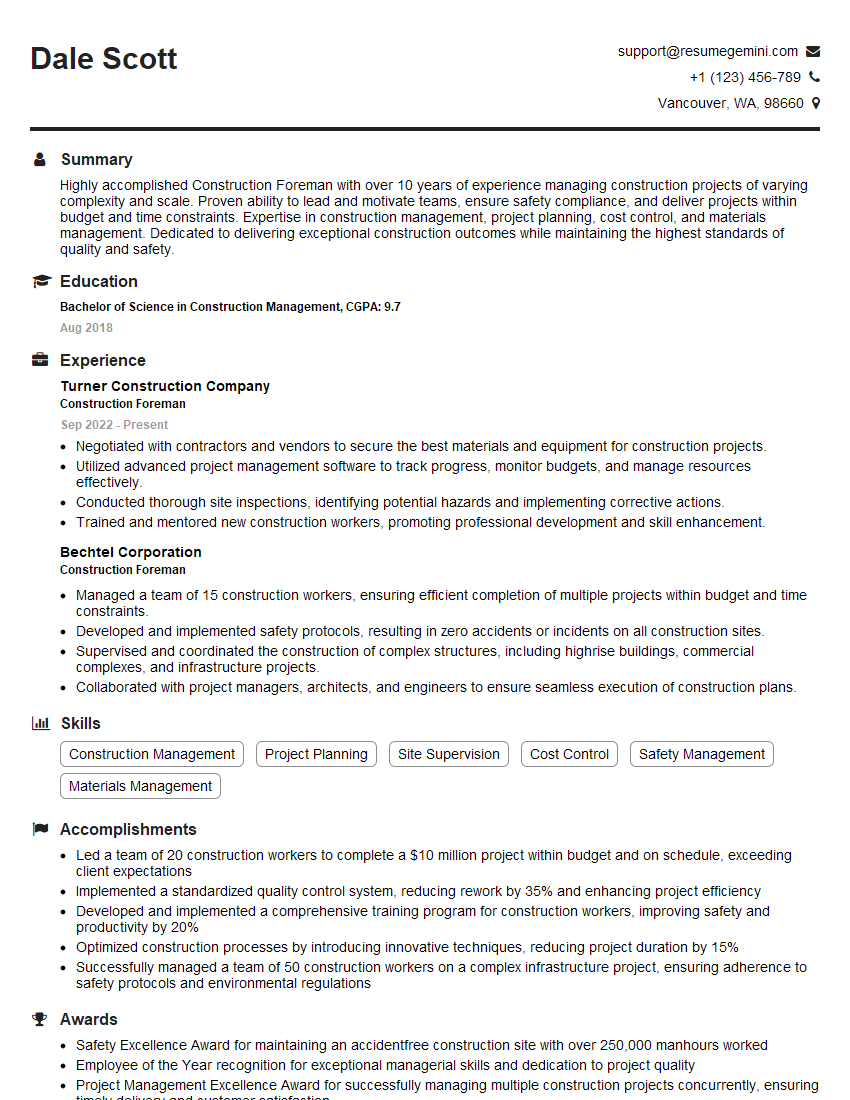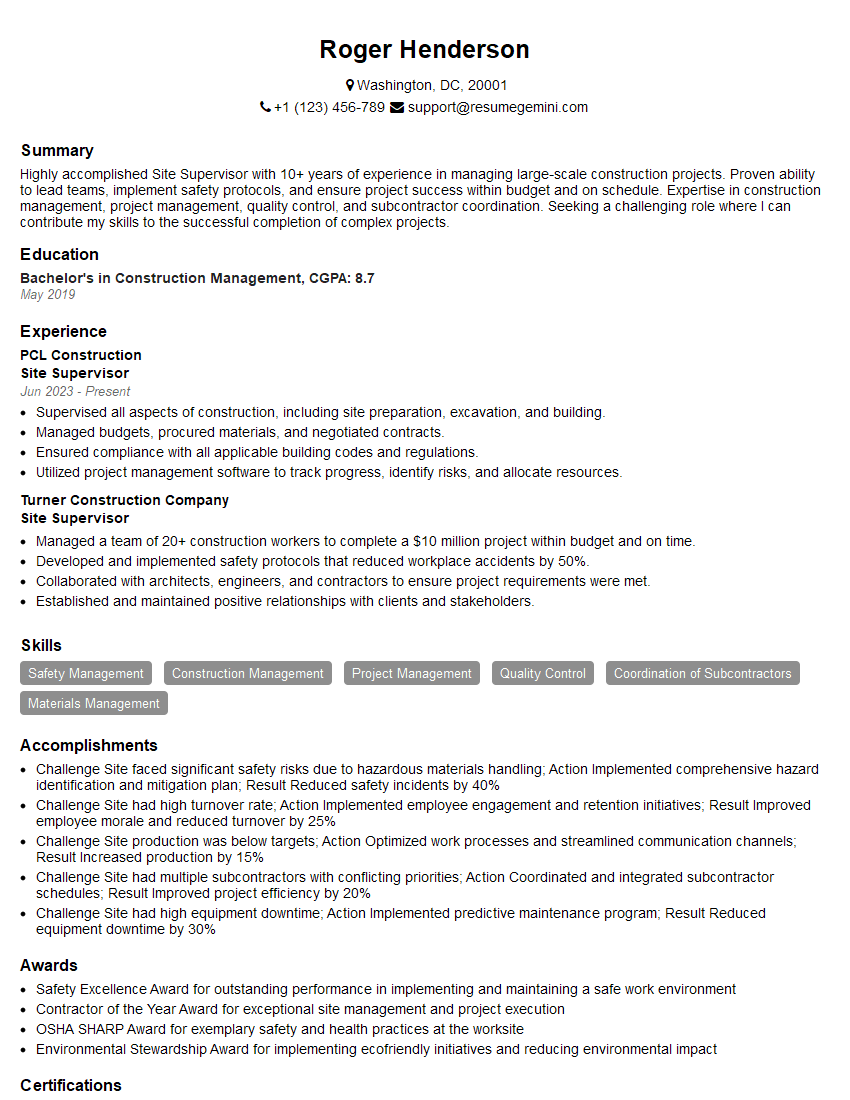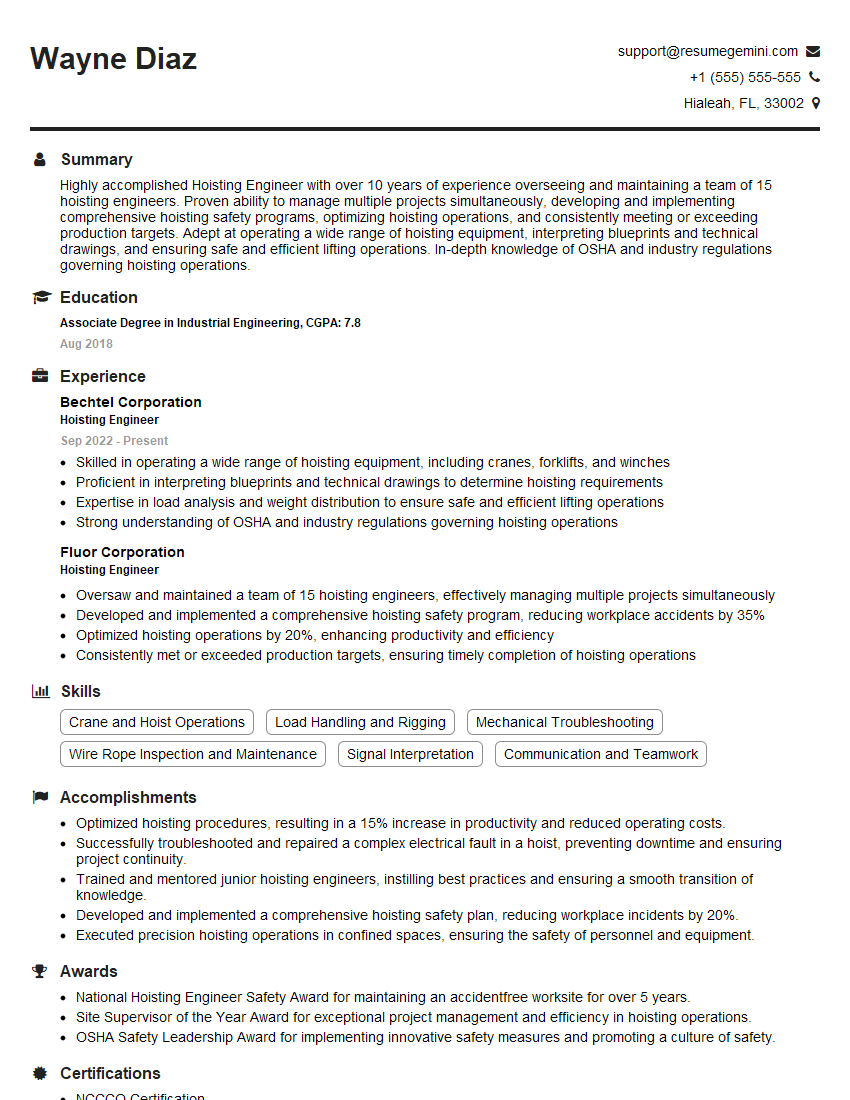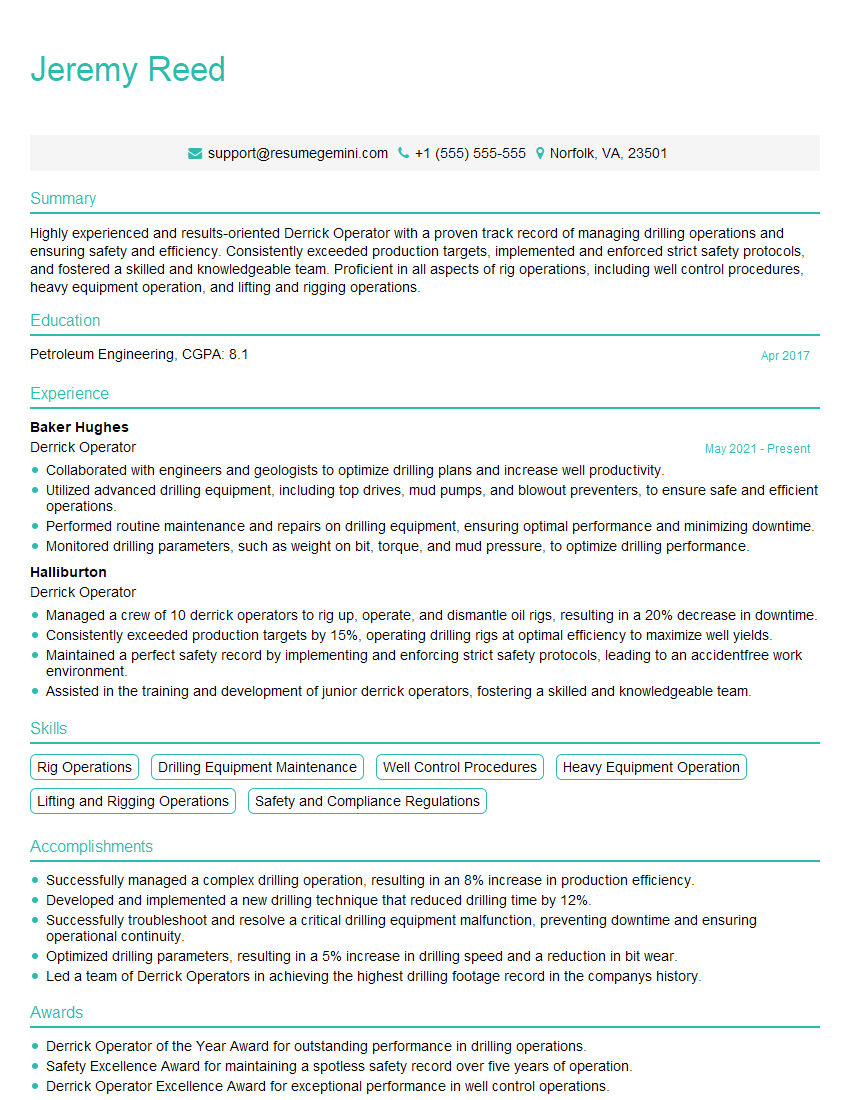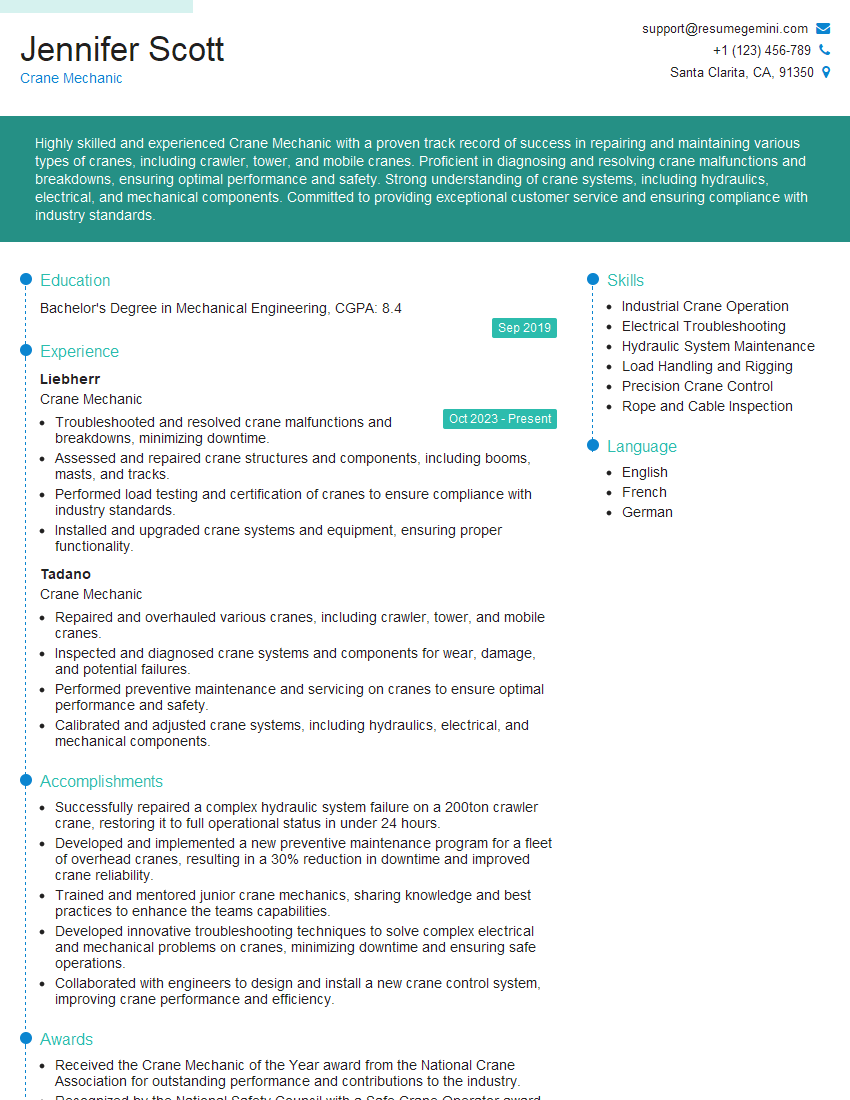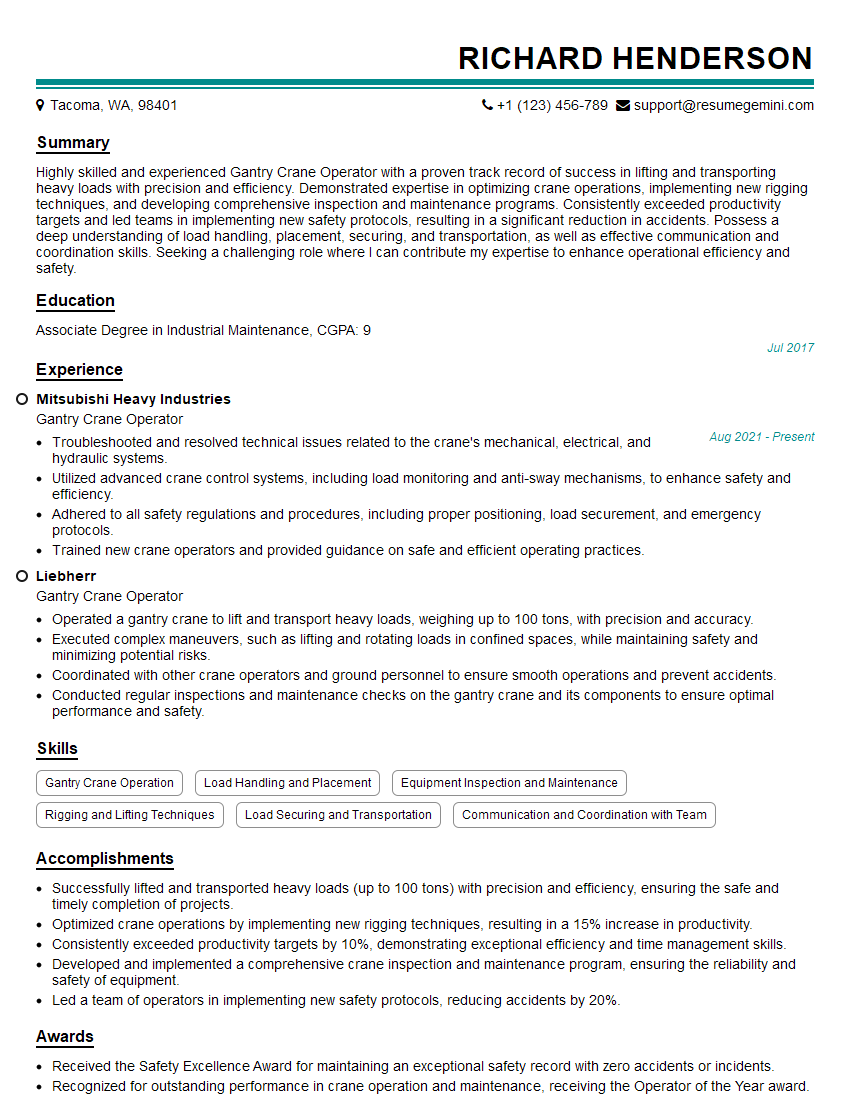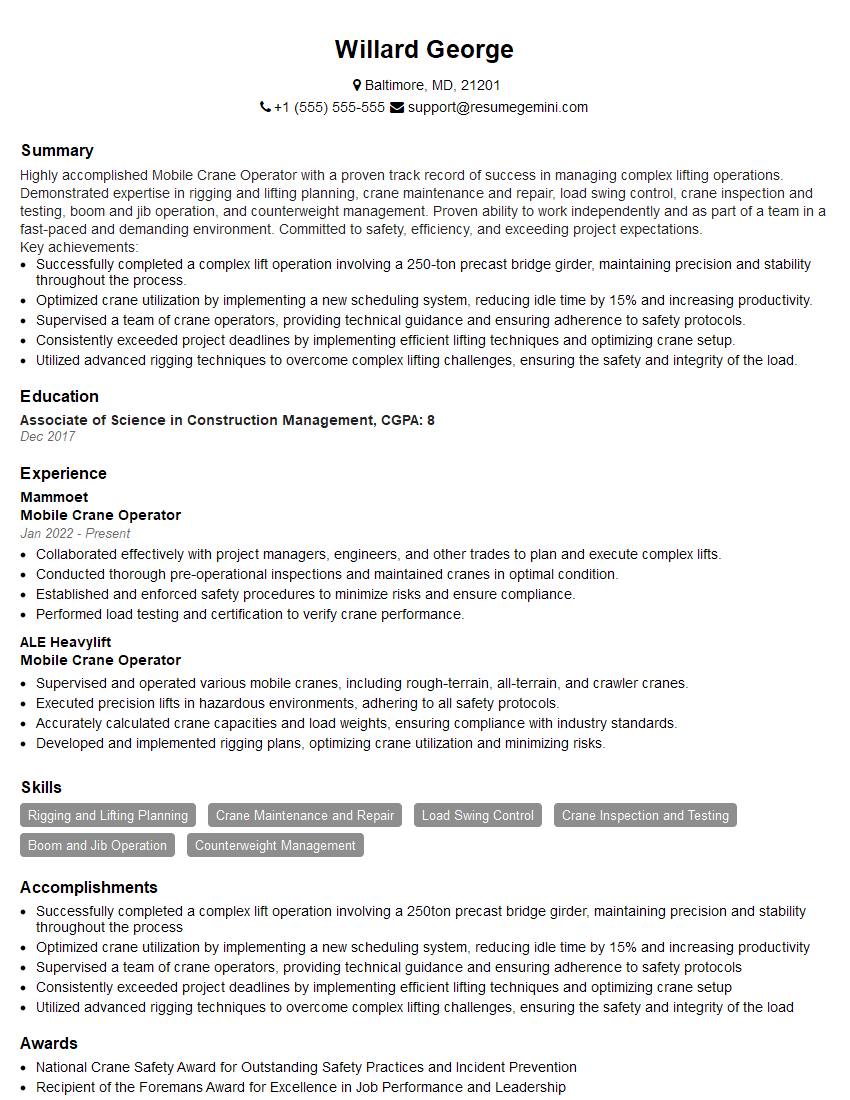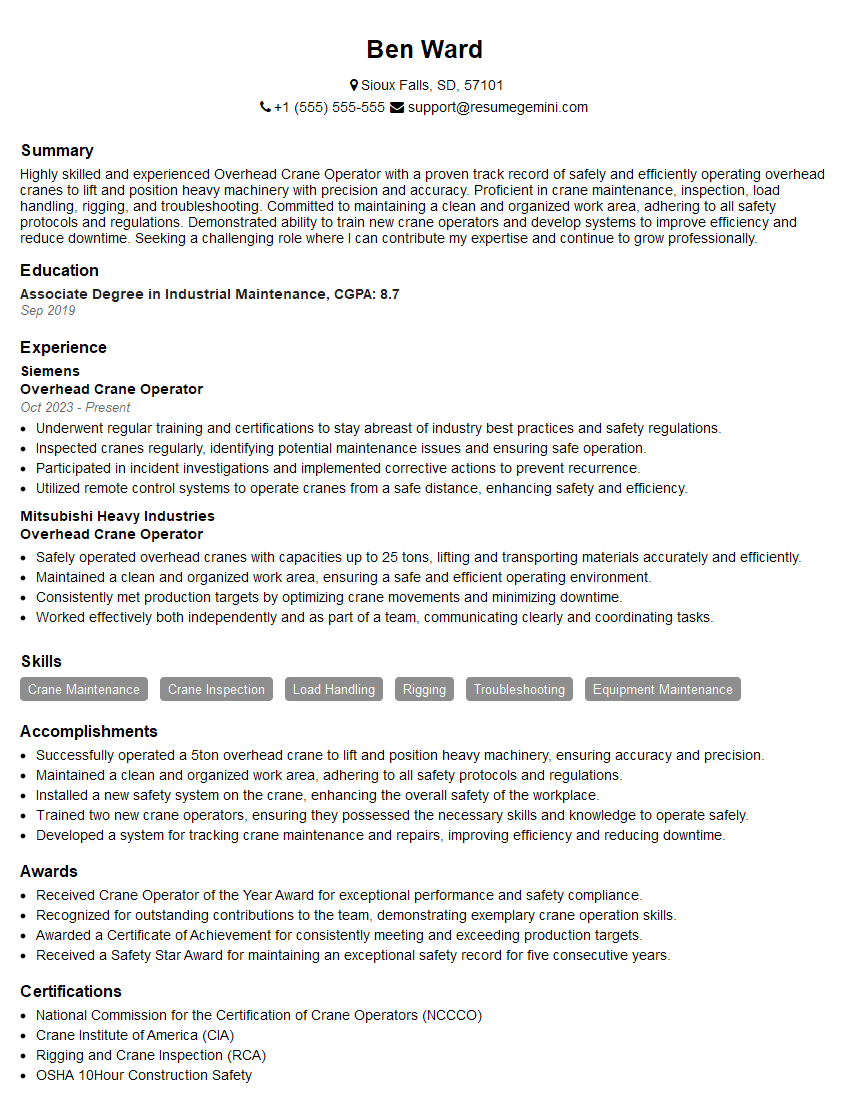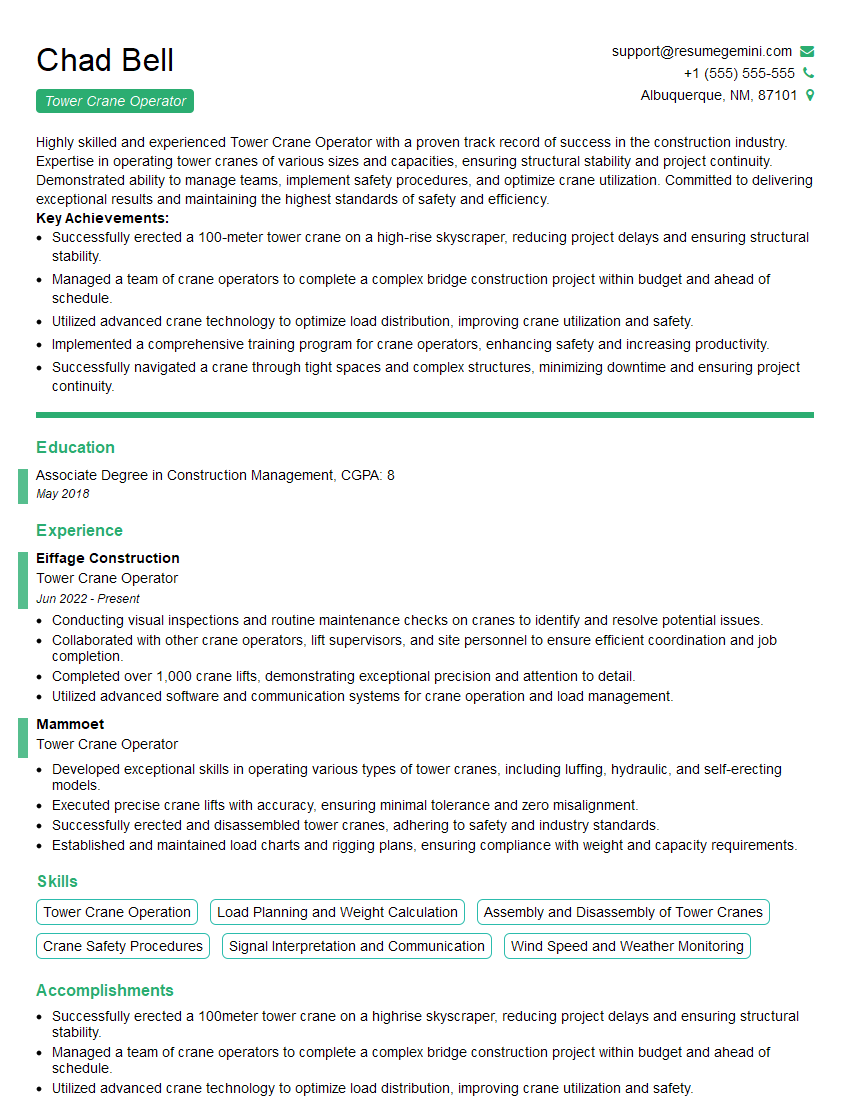Interviews are more than just a Q&A session—they’re a chance to prove your worth. This blog dives into essential Operating cranes and other equipment interview questions and expert tips to help you align your answers with what hiring managers are looking for. Start preparing to shine!
Questions Asked in Operating cranes and other equipment Interview
Q 1. Describe your experience operating different types of cranes.
Throughout my career, I’ve operated a wide variety of cranes, including tower cranes, mobile cranes (both crawler and wheeled), overhead cranes, and even some specialized cranes like gantry cranes. Each type presents unique challenges and demands different operational techniques. For example, operating a tower crane requires a deep understanding of its reach limitations and the impact of wind conditions on load stability, something not as critical when operating a smaller overhead crane in a controlled indoor environment. Working with crawler cranes necessitates a thorough understanding of ground conditions and the risk of ground instability, while wheeled mobile cranes demand more attention to maneuvering and road safety. I’ve successfully completed projects involving the lifting of heavy equipment, structural components, and prefabricated sections using these different types of cranes, always prioritizing safety and efficiency.
My experience isn’t limited to simply operating the crane. I’m proficient in pre-operational checks, load planning, and collaborating with riggers to ensure the smooth execution of lifting operations. This diverse experience has equipped me with a broad understanding of crane limitations and best practices.
Q 2. Explain the different types of crane hooks and their applications.
Crane hooks are crucial components, and their selection is vital for safe lifting. Different types are designed for different applications.
- Standard Hook: The most common type, suitable for general lifting purposes. It’s simple and reliable.
- Clevis Hook: Features a clevis at the head, allowing for easier attachment of slings or other lifting devices. Excellent for situations where quick connections are needed.
- Grab Hooks: Designed to grasp and lift objects with irregular shapes. Often used for demolition or scrap metal handling.
- Heavy-duty Hooks: Manufactured from high-strength steel and designed for lifting exceptionally heavy loads. They typically have a larger hook opening and a higher safety factor.
- Self-closing Hooks: Automatically close around the load, enhancing safety and efficiency, particularly when lifting cylindrical or round objects.
The selection depends on factors such as load weight, shape, material, and the required method of attachment. For instance, a grab hook is unsuitable for delicate materials, while a standard hook might be insufficient for a very heavy, oddly-shaped load. Choosing the wrong hook can compromise safety and even lead to accidents.
Q 3. What are the critical safety checks before operating a crane?
Safety is paramount. Before operating any crane, a comprehensive pre-operational check is mandatory. This includes:
- Visual Inspection: Thoroughly examine the crane for any visible damage, wear, or defects, including the hook, cables, sheaves, and boom. Check for oil leaks, loose bolts, or any other signs of malfunction.
- Mechanical Check: Test all crane functions, including hoisting, lowering, swinging, and traversing mechanisms. Ensure smooth operation without any unusual noises or vibrations.
- Brake Test: Verify that the brakes are functioning correctly and are capable of holding the maximum load safely.
- Load Chart Verification: Confirm that the load chart is present, up-to-date, and clearly understood. The operator must know the crane’s lifting capacity under varying conditions.
- Safety Device Checks: Ensure that all safety devices, such as limit switches, overload protection, and emergency stops, are functioning correctly.
- Environmental Assessment: Evaluate the weather conditions (wind speed, visibility), the surrounding area for obstructions, and potential hazards such as power lines or nearby personnel.
Only after a satisfactory completion of these checks, and after receiving clearance from a supervisor (where applicable), should the crane operation commence.
Q 4. How do you ensure load stability during crane operations?
Load stability is critical to prevent accidents. Several techniques ensure this:
- Proper Rigging: Using the appropriate slings, chains, or other lifting devices that are properly sized and correctly attached to both the load and the hook. Incorrect rigging is a major source of instability.
- Balanced Load: Ensure that the load is evenly distributed to prevent it from swinging or tipping. For unusually shaped loads, careful planning and potentially specialized rigging might be required.
- Smooth Operation: Avoid sudden movements or jerky actions during lifting, lowering, or swinging operations. This minimizes the risk of oscillations.
- Wind Considerations: Wind speed is a significant factor; high winds can make it very difficult to control a load. Operations should be suspended when wind conditions exceed the crane’s specified limits.
- Load Chart Adherence: Never exceed the crane’s rated capacity, and always consider factors like boom angle and radius when determining the safe working load.
Imagine lifting a heavy, oddly-shaped object. If not properly rigged and balanced, it could easily sway and cause an accident. Smooth, controlled movements and respect for the crane’s limitations are key.
Q 5. Describe your experience with load charts and weight calculations.
I have extensive experience using load charts and performing weight calculations. Load charts provide the safe working load limits for the crane under different configurations (boom length, angle, etc.). Before any lift, I carefully assess the weight of the load and confirm that it’s well within the crane’s capacity for the specific configuration being used. I’ve used various methods for weight calculation, including direct weighing when possible, volume and density calculations for materials with known densities, and estimations based on engineering drawings when direct measurements aren’t feasible. My calculations always account for safety factors, ensuring that the chosen crane and rigging are more than adequately strong enough to handle the actual load.
A real-world example: During a construction project, we had to lift a large steel beam. Using the beam’s dimensions and the steel’s density, I calculated its weight and checked that it was safely within the rated capacity of the mobile crane we had selected. A thorough understanding of these calculations ensures efficient and, more importantly, safe crane operations.
Q 6. What are the common causes of crane accidents and how to prevent them?
Crane accidents are often caused by a combination of factors. Common causes include:
- Improper Rigging: Incorrect attachment or use of slings, chains, or other lifting gear. This leads to load instability and potential falls.
- Exceeding Load Capacity: Overloading the crane beyond its rated capacity, leading to structural failure or tipping.
- Operator Error: Lack of training, poor judgment, or failure to follow safety procedures.
- Mechanical Failure: Defects in the crane’s structure, mechanisms, or safety devices. Regular maintenance is crucial to prevent this.
- Environmental Factors: High winds or poor visibility significantly increase the risk of accidents.
Prevention Strategies:
- Comprehensive Training: Operators must receive thorough training and certification. Regular refresher courses reinforce safety practices.
- Regular Inspections and Maintenance: Preventive maintenance programs significantly reduce the risk of mechanical failure.
- Strict Adherence to Safety Procedures: All personnel involved must follow established safety protocols.
- Thorough Pre-lift Planning: Detailed load plans, including weight calculations, rigging schemes, and environmental assessments, are essential.
- Clear Communication: Effective communication between the crane operator, riggers, and ground crew prevents misunderstandings and accidents.
The cost of an accident – in terms of damage, injuries, and potential legal consequences – far outweighs the cost of implementing robust safety measures. A proactive approach is always best.
Q 7. Explain the procedures for rigging and unrigging loads.
Rigging and unrigging procedures are crucial for load safety and efficiency. The steps are similar but reversed for each process:
Rigging:
- Inspect the Load: Assess the load’s weight, dimensions, and center of gravity. Identify any potential hazards.
- Select Appropriate Rigging Gear: Choose slings, chains, or other lifting devices appropriate for the load’s weight, shape, and material. Ensure they are in good condition and properly rated.
- Attach Rigging Gear: Securely attach the rigging gear to both the load and the crane hook. This requires knowledge of various hitching methods and appropriate knots.
- Inspect Connections: Double-check all connections for security. Ensure there’s no slippage or risk of detachment.
- Communicate with Crane Operator: Signal to the crane operator that the load is ready for lifting.
Unrigging:
- Lower Load Slowly: Carefully lower the load to the ground, ensuring a steady and controlled descent.
- Secure the Load: Use appropriate means to prevent the load from rolling or shifting once on the ground.
- Detach Rigging Gear: Carefully and methodically detach the rigging gear from the load and the crane hook. Always follow correct procedures to avoid injury or damage.
- Inspect Rigging Gear: Examine the rigging gear for any damage or wear. Damaged equipment should be removed from service immediately.
Throughout both processes, maintaining clear communication and following safety procedures are critical to preventing accidents. Rigging and unrigging may seem simple, but incorrect execution can have serious repercussions. I always prioritize safety first.
Q 8. How do you handle emergency situations during crane operation?
Emergency situations during crane operation demand swift, decisive action. My priority is always the safety of personnel and property. My response is guided by a structured approach:
- Immediate Stoppage: The first step is always to immediately cease all crane operations. This prevents further escalation of the situation.
- Assessment: I conduct a rapid risk assessment to determine the nature and extent of the emergency. Is it a mechanical failure, a load instability, or a personnel hazard? This guides my subsequent actions.
- Emergency Procedures: I am well-versed in the specific emergency procedures outlined in the site safety plan and the crane’s operational manual. This might involve activating emergency brakes, lowering the load slowly, or evacuating the area.
- Communication: Clear and concise communication is crucial. I’ll immediately inform the site supervisor, safety officer, and other relevant personnel about the emergency. This ensures a coordinated response.
- Containment and Mitigation: Once the immediate danger is neutralized, I’ll work to contain the situation and mitigate any further risks. This might involve securing the crane, isolating the affected area, or implementing damage control measures.
- Post-Incident Report: After the emergency is resolved, a thorough report documenting the event, the actions taken, and any contributing factors is essential. This helps prevent similar incidents in the future.
For example, during a recent operation, a sudden gust of wind caused a slight sway in the suspended load. I immediately stopped the crane, assessed the wind speed and direction, and lowered the load slowly to a safe position, ensuring clear communication with the ground crew throughout the process. The incident was then reported, and preventative measures for future high-wind situations were discussed and implemented.
Q 9. What is your experience with different types of crane signaling systems?
I’m experienced with various crane signaling systems, ranging from traditional hand signals to advanced radio communication and electronic systems. My proficiency includes:
- Hand Signals: I’m proficient in the standard hand signals for crane operation, as defined in OSHA regulations and industry best practices. These are crucial for situations where radio communication is not feasible or reliable.
- Two-Way Radios: I regularly use two-way radios for clear and immediate communication between the crane operator and the ground crew. This allows for precise instructions and real-time feedback, particularly important for complex lifting operations.
- Electronic Signaling Systems: I have experience with more sophisticated electronic systems where the signaler uses a remote control device to direct the crane. These systems increase precision and reduce the risk of miscommunication.
Understanding the limitations of each system is key. For instance, hand signals require a clear line of sight, while radio communication can be affected by interference or range limitations. I always select the most appropriate signaling method based on the specific job conditions and ensure clear communication with the signaling personnel.
Q 10. Describe your experience with preventative maintenance on cranes.
Preventative maintenance is crucial for ensuring crane safety and operational efficiency. My experience encompasses a comprehensive approach:
- Regular Inspections: I conduct daily pre-operational inspections, checking for any visible damage, wear and tear, fluid leaks, and loose components. These checks follow a standardized checklist.
- Scheduled Maintenance: I participate in and am familiar with scheduled maintenance programs, which include lubrication, component replacements, and more in-depth mechanical checks according to the manufacturer’s guidelines and regulatory requirements. This might involve things like wire rope inspections, brake tests, and load testing.
- Record Keeping: Maintaining detailed and accurate records of all inspections and maintenance activities is vital. This documentation allows for tracking of the crane’s operational history, identifying potential issues early on, and ensuring compliance with regulations.
For example, during a recent scheduled maintenance on a tower crane, I noticed slight wear on a bearing. This was promptly reported, and the bearing was replaced to prevent a potential catastrophic failure. Regular maintenance is far more cost-effective than dealing with emergency repairs resulting from neglected maintenance.
Q 11. How do you identify and report potential hazards on a construction site?
Identifying and reporting hazards is an integral part of my work. I employ a proactive approach:
- Proactive Observation: I constantly scan my surroundings for potential hazards such as unstable ground, overhead obstructions, electrical lines, and unsafe working practices by others.
- Reporting Mechanism: I use the established reporting system on the construction site, whether it’s a formal incident reporting system, a daily safety report, or directly communicating with the site supervisor or safety officer.
- Documentation: I ensure that my reports are detailed, accurate, and include relevant information such as the location, nature of the hazard, and any potential consequences. I use photos and sketches when helpful.
- Follow-up: I also follow up on reported hazards to ensure that corrective action has been taken.
For example, I once noticed a damaged section of scaffolding near the crane’s operational area. I immediately reported this to the site supervisor, and work in that area was stopped until the scaffolding was repaired, preventing a possible collapse and potential injury to personnel.
Q 12. What are the legal requirements and regulations for operating cranes?
Crane operation is subject to strict legal requirements and regulations, varying by jurisdiction. Generally, these regulations focus on:
- Licensing and Certification: Operators must possess the appropriate licenses and certifications to operate specific types of cranes. These often involve demonstrating competency through examinations and training.
- Safety Standards: Strict adherence to safety standards such as OSHA regulations (in the US) or equivalent standards in other countries is mandatory. These standards cover aspects like pre-operational inspections, load capacity limits, signaling procedures, and emergency response plans.
- Equipment Inspection and Maintenance: Regular inspections and maintenance of the crane are required to ensure its safe operation. Detailed records of these activities must be kept.
- Load Capacity and Stability: Calculations and verification regarding load capacity and stability are essential, ensuring the crane’s load doesn’t exceed its safe working limits.
Ignorance of these regulations can lead to serious penalties, including fines and suspension of operation. Staying up-to-date on the latest regulations and attending refresher courses is crucial for maintaining compliance and ensuring safety.
Q 13. Explain your understanding of load capacity and safe working loads.
Understanding load capacity and safe working loads is paramount for safe crane operation. The load capacity represents the maximum weight a crane can lift under ideal conditions. However, the safe working load (SWL) is always lower and accounts for various factors that reduce the crane’s capacity, such as:
- Wind Speed: High winds significantly reduce the safe working load.
- Crane Angle: Lifting at an angle reduces the crane’s capacity.
- Radius of Lift: The distance of the load from the crane’s center also affects its capacity.
- Condition of the Crane: Wear and tear on components can reduce the SWL.
I always refer to the crane’s load chart which provides the SWL for different configurations and conditions. Never exceeding the SWL is a fundamental principle of safe crane operation. For instance, if the SWL at a particular radius is 10 tons, but the wind speed is high, I might reduce my lifting capacity to 8 tons to account for the adverse weather conditions. This ensures a safety margin to prevent overloading and potential accidents.
Q 14. How do you communicate effectively with other workers on the site?
Effective communication is essential for a safe and productive worksite. I utilize various methods to ensure clear and concise communication with other workers:
- Clear and Concise Language: I use plain language, avoiding jargon unless all parties understand the terminology. I confirm understanding before proceeding with any task.
- Visual Aids: When necessary, I employ visual aids such as hand signals, drawings, or written instructions to clarify complex instructions.
- Active Listening: I pay close attention to what others are saying, confirming understanding before acting on their instructions or requests.
- Pre-Task Planning: Before commencing any lift, I hold a brief meeting with the riggers, signalers, and other relevant personnel to outline the lifting procedure, clarify roles and responsibilities, and ensure everyone is on the same page.
- Non-Verbal Communication: I pay attention to non-verbal cues like body language to ensure that everyone is comfortable and understands the situation. This is especially important for safety-critical procedures.
For example, before lifting an exceptionally large or delicate piece of equipment, I always hold a pre-lift meeting to ensure that everyone understands the lifting plan, potential hazards, and emergency procedures. This collaborative approach minimizes the risk of misunderstandings and ensures a safe and efficient operation.
Q 15. Describe your experience working at height.
My experience working at height spans over 15 years, encompassing various roles from crane operator to site supervisor. I’ve consistently prioritized safety and adhered to strict protocols. This includes rigorous training in fall protection techniques, utilizing safety harnesses and lanyards, and understanding the limitations of different types of fall arrest systems. I’ve worked on projects involving high-rise buildings, bridge construction, and industrial plant maintenance, always ensuring my work practices meet and exceed regulatory requirements. For instance, on a recent high-rise construction project, I was responsible for the safe and efficient lifting of prefabricated building components using a tower crane. Regular inspections of the crane’s safety mechanisms and my personal equipment were a top priority, ensuring everyone’s safety at those considerable heights.
Career Expert Tips:
- Ace those interviews! Prepare effectively by reviewing the Top 50 Most Common Interview Questions on ResumeGemini.
- Navigate your job search with confidence! Explore a wide range of Career Tips on ResumeGemini. Learn about common challenges and recommendations to overcome them.
- Craft the perfect resume! Master the Art of Resume Writing with ResumeGemini’s guide. Showcase your unique qualifications and achievements effectively.
- Don’t miss out on holiday savings! Build your dream resume with ResumeGemini’s ATS optimized templates.
Q 16. How do you handle challenging weather conditions during crane operation?
Operating a crane in challenging weather conditions requires a heightened level of awareness and adherence to safety protocols. High winds, heavy rain, snow, and ice all pose significant risks. My approach involves a risk assessment before commencing operations. This includes checking weather forecasts, assessing wind speeds, and evaluating the visibility. If conditions are deemed unsafe, I will halt operations immediately and inform the site supervisor. For example, if wind speeds exceed the crane’s operational limits, or visibility drops below a safe level, operations are suspended. In moderate conditions, I’ll adjust my operating techniques – using slower movements and taking extra precautions to avoid swaying loads. The use of appropriate signaling systems also ensures clear communication with ground crew in low visibility conditions.
Q 17. What is your experience with different types of crane control systems?
I’m proficient in various crane control systems, including both analog and digital systems. I have experience with both conventional lever-operated controls and more modern computerized systems with digital displays and load moment indicators (LMIs). LMIs are crucial for preventing crane overloading, a key safety aspect. My experience also includes working with radio remote controls, which increase efficiency and safety in certain situations. Each system presents its own unique challenges and advantages. For instance, understanding the nuances of a computerized system’s safety interlocks and its feedback mechanisms is essential for efficient and safe operation. I’ve also worked with older analog systems which required a deeper understanding of the mechanical linkages and their limitations. Adaptability and continuous learning are vital in keeping pace with advancements in crane technology.
Q 18. Explain the importance of pre-operational checks and inspections.
Pre-operational checks and inspections are paramount for ensuring crane safety and preventing accidents. These checks cover all aspects of the crane, including structural integrity, braking systems, electrical components, load-bearing capacities, and safety devices like limit switches and emergency stops. I meticulously follow a checklist, inspecting each item systematically. This involves visual inspections, functional tests, and load testing (where applicable). A thorough inspection ensures that the crane is in optimal condition for operation and helps identify potential issues before they lead to failures or accidents. Neglecting these checks could lead to catastrophic consequences such as structural collapse, load drops, or electrocution. I view pre-operational checks not merely as a routine, but as a critical step in safeguarding lives and property.
Q 19. How do you deal with unexpected load shifts or imbalances?
Unexpected load shifts or imbalances are serious situations that demand immediate and correct responses. My training emphasizes quick thinking and decisive action. The first step is to immediately stop all crane movements to prevent further destabilization. Then, I carefully assess the situation, determining the cause of the shift (e.g., uneven load distribution, wind gusts, or a malfunctioning sling). Depending on the severity and cause, I might adjust the crane’s position to compensate for the imbalance or use additional slings to redistribute the weight. If the imbalance is severe or I cannot safely rectify the situation, I’ll lower the load slowly and carefully, calling for assistance if needed. The safety of personnel on the ground is always a primary concern. Regular training and experience allow me to respond calmly and effectively to these incidents.
Q 20. What is your experience with troubleshooting crane malfunctions?
Troubleshooting crane malfunctions requires a systematic approach. I begin with a thorough inspection, identifying the specific symptom of the malfunction. Is it a hydraulic leak, an electrical fault, or a mechanical problem? Once identified, I consult the crane’s manual and utilize my experience to diagnose the root cause. Simple issues, like a blown fuse, can often be resolved quickly. More complex problems might necessitate calling in a qualified technician. For example, if the crane’s hoisting mechanism fails, I wouldn’t attempt to repair it myself; I’d immediately shut down the crane and contact the maintenance team. Safety is paramount; attempting repairs beyond my skillset could lead to further damage or injury. My experience in diagnosing problems is built upon years of hands-on experience and regular training sessions on various crane systems.
Q 21. Describe your familiarity with different types of lifting slings and their applications.
My experience encompasses various lifting slings, including wire rope slings, chain slings, synthetic web slings, and round slings. Each type has its specific application and limitations. Wire rope slings offer high tensile strength but are susceptible to wear and damage from abrasion. Chain slings are robust and suitable for heavy loads, but require regular inspections for elongation or damage. Synthetic web slings are lighter and more versatile but are less resistant to sharp edges. Round slings offer good abrasion resistance and are often used for lifting cylindrical objects. The selection of an appropriate sling depends on the load’s weight, shape, and material, as well as the environmental conditions. Using the wrong type of sling could lead to load failure, resulting in accidents or property damage. Safety regulations and manufacturer recommendations are strictly followed when choosing and inspecting slings.
Q 22. Explain your understanding of crane stability and its factors.
Crane stability refers to the crane’s ability to remain upright and prevent tipping or overturning during operation. It’s crucial for safety and preventing accidents. Several factors influence stability, and understanding them is paramount.
- Load Weight and Center of Gravity: The heavier the load and the further it’s positioned from the crane’s center, the greater the risk of instability. Think of it like balancing a pencil – the further you move the weight, the harder it is to keep it balanced.
- Crane Type and Design: Different cranes have different stability characteristics. A crawler crane, with its tracks, offers superior stability compared to a mobile crane on wheels, particularly on uneven terrain. Boom length also plays a significant role; longer booms generally reduce stability.
- Ground Conditions: Soft, uneven, or sloping ground significantly reduces stability. A crane’s footing is vital; it needs a firm, level base.
- Wind Speed and Direction: Strong winds can exert significant force on the crane and load, increasing the chance of tipping. This is especially true for taller cranes with longer booms.
- Outrigger Deployment (for mobile cranes): Outriggers extend the crane’s base, drastically improving stability. Proper deployment is crucial and should be done according to the manufacturer’s instructions and load charts.
- Swing Radius: The distance the boom extends horizontally affects stability. Greater distances generally increase instability.
For example, I once worked on a project where a mobile crane was operating near a sloping embankment. We had to carefully calculate the load weight, adjust the outrigger positioning, and monitor wind conditions to ensure stability and prevent any accidents. We even used ground mats to improve the crane’s footing on the softer soil.
Q 23. How do you maintain accurate records and documentation related to crane operations?
Maintaining accurate records is non-negotiable for crane operations. This is vital for safety, compliance, and potential legal issues. My approach involves a multi-faceted system:
- Pre-Operational Checklists: These meticulously document the inspection of the crane before each use, including checks on mechanical components, safety devices, and load-bearing capacity.
- Daily Crane Logs: These logs record every lift, including load weight, location, and any unusual occurrences. They should be signed and dated by the crane operator.
- Maintenance Records: A detailed record of all maintenance performed on the crane, including inspections, repairs, and certifications, is crucial for demonstrating ongoing compliance.
- Training and Certification Records: Documentation of all operators’ training and certifications are vital, proving competency and legal compliance.
- Incident Reports: Any accidents or near-misses are immediately documented in detail, including witness statements, photos, and corrective actions taken.
- Digital Systems: Many modern cranes have onboard computers that record operational data. This data is invaluable for analysis and improvement.
I always ensure records are kept securely, organized, and readily accessible to authorized personnel. I use a combination of physical logs and digital databases, cross-referencing the two to guarantee data integrity.
Q 24. What is your experience with different types of crane attachments?
My experience encompasses a wide range of crane attachments, each designed for specific lifting tasks.
- Hooks: The most common attachment, used for lifting various loads. Different hook designs cater to varying load types and weights.
- Clamps: Used for gripping and lifting items such as steel plates or pipes without the need for slings.
- Magnets: Used for lifting ferrous materials, efficient for handling large quantities of scrap metal.
- Buckets: For lifting bulk materials like aggregates, demolition debris, or grain.
- Spreader Beams: Used to distribute the load across multiple points, enabling the lifting of oversized, awkward loads.
- Grab Buckets: Used for lifting materials like logs or scrap, often with the ability to open and close.
- Specialized Attachments: I’ve also worked with specialized attachments such as vacuum lifters for glass, concrete buckets for pouring, and even custom-designed attachments for unique project needs.
Proper attachment selection is critical for safe and efficient lifting. The wrong attachment can damage both the load and the crane, so careful consideration is always required. I always ensure the chosen attachment is rated for the weight and type of load to be lifted.
Q 25. Describe your knowledge of OSHA or other relevant safety regulations.
My knowledge of OSHA (Occupational Safety and Health Administration) regulations, and other relevant safety standards is extensive. I’m familiar with the specific regulations covering crane operation, including:
- Crane Inspection and Maintenance: Regular inspections, documented maintenance, and operator certifications are crucial.
- Load Capacity and Stability: Understanding the crane’s load charts, and ensuring safe working loads and stability are maintained.
- Signal Person Requirements: The necessity of a qualified signal person for certain operations and the specific procedures to follow.
- Personal Protective Equipment (PPE): Mandatory use of appropriate PPE such as hard hats, safety glasses, and high-visibility clothing.
- Emergency Procedures: Having a plan in place for dealing with accidents or emergencies.
- Environmental Considerations: Understanding regulations concerning the environment and potential hazards.
Beyond OSHA, I also have experience with ANSI (American National Standards Institute) and other industry-specific standards, ensuring that the operations are compliant with all relevant guidelines. Compliance is not just a matter of avoiding fines, but ensuring the safety of everyone on-site.
Q 26. How do you ensure the proper use of personal protective equipment (PPE)?
Ensuring proper PPE use is a cornerstone of safety. My approach involves:
- Training and Education: Every individual on-site receives training on the appropriate PPE and its correct usage. This includes demonstrations and practical application.
- Inspection and Maintenance: We regularly inspect PPE for damage or wear and tear, ensuring it is in good working order. Damaged PPE is immediately replaced.
- Enforcement: Strict adherence to PPE use is enforced on-site. This includes regular checks to ensure compliance.
- Accessibility: Appropriate PPE is readily available and easily accessible at designated locations throughout the worksite.
- Communication: Open communication on the importance of PPE is maintained to encourage a safety-first culture.
For example, I once had to stop work because an operator was not wearing his safety harness. It was a brief delay, but it ensured his safety. Preventing accidents is far more efficient than dealing with their consequences.
Q 27. Explain your experience with using different types of crane sensors and monitoring systems.
My experience with crane sensors and monitoring systems is significant. Modern cranes often incorporate a variety of these systems to enhance safety and efficiency.
- Load Moment Indicators (LMIs): These sensors constantly monitor the load weight, boom angle, and radius, providing real-time feedback to prevent overloading or instability. I’ve extensively used LMIs across various crane types.
- Wind Speed Sensors: These measure wind speed and direction, automatically halting operations if conditions exceed safe limits. This crucial safety feature has prevented numerous potential accidents.
- Angle Sensors: These monitor boom angle to ensure it stays within the safe operating limits, preventing overextension.
- Anti-Collision Systems: Sophisticated systems using sensors to prevent collisions between the crane and surrounding structures or other equipment.
- Data Logging Systems: These systems continuously record crane operations data, providing a detailed record for analysis and improvement.
For example, I once worked on a project where an anti-collision system prevented a crane from colliding with a nearby building. The investment in advanced sensors and monitoring systems was undeniably justified by the prevention of a potentially catastrophic accident.
Q 28. Describe your problem-solving approach in a high-pressure crane operation scenario.
In high-pressure scenarios, a systematic approach is critical. My problem-solving strategy follows these steps:
- Assess the Situation: Quickly evaluate the immediate problem. Is it a mechanical issue, a safety concern, or a logistical problem?
- Prioritize Safety: Ensure the safety of all personnel is the top priority. This may involve temporarily stopping operations.
- Identify Potential Solutions: Brainstorm possible solutions, considering the available resources and constraints.
- Select the Best Solution: Choose the solution that best addresses the problem while minimizing risks and potential disruptions.
- Implement the Solution: Execute the chosen solution methodically, paying close attention to detail.
- Monitor and Evaluate: Observe the situation closely to ensure the problem is resolved and that no further issues arise.
- Document Everything: Record the event, solution, and lessons learned for future reference and improvement.
For instance, during a large construction project, a critical lift was delayed due to a sudden downpour. Following my systematic approach, I assessed the risk (unsafe ground conditions), prioritized safety (halted operations), brainstormed solutions (using alternative lifting equipment or waiting for the rain to subside), and implemented the most appropriate (waiting) with continuous monitoring. This averted a potential accident and prevented significant delays. A detailed report was created documenting the situation and the implemented actions.
Key Topics to Learn for Operating Cranes and Other Equipment Interviews
- Crane Types and Mechanisms: Understanding the differences between various crane types (e.g., tower, mobile, overhead) and their operating mechanisms (e.g., hydraulics, electric motors). Explore the strengths and limitations of each type.
- Safety Procedures and Regulations: Mastering safety protocols, including pre-operational checks, load capacity calculations, signaling systems, and emergency procedures. Familiarize yourself with relevant OSHA or industry-specific regulations.
- Load Handling and Stability: Develop a strong understanding of load weight distribution, center of gravity, and techniques for safe and efficient load handling. Practice problem-solving scenarios involving unbalanced loads or challenging lifting environments.
- Maintenance and Troubleshooting: Learn about routine maintenance tasks, common equipment malfunctions, and basic troubleshooting techniques. Understanding preventative maintenance is crucial for operational efficiency and safety.
- Communication and Teamwork: Effective communication with riggers, signal persons, and other team members is paramount. Practice clear and concise communication skills, emphasizing safety concerns and potential hazards.
- Advanced Operating Techniques: Explore specialized techniques such as lifting in confined spaces, working at height, and handling oversized or delicate loads. This demonstrates a commitment to advanced skill development.
Next Steps
Mastering the operation of cranes and other heavy equipment opens doors to exciting and well-compensated careers in construction, logistics, and manufacturing. To maximize your job prospects, it’s vital to present your skills effectively. An ATS-friendly resume is crucial for getting your application noticed by recruiters and hiring managers. ResumeGemini can help you create a professional, impactful resume that highlights your qualifications and experience in operating cranes and other equipment. We provide examples of resumes tailored to this specific field to guide you in crafting a compelling application. Take the next step towards your dream career today!
Explore more articles
Users Rating of Our Blogs
Share Your Experience
We value your feedback! Please rate our content and share your thoughts (optional).
What Readers Say About Our Blog
Hello,
We found issues with your domain’s email setup that may be sending your messages to spam or blocking them completely. InboxShield Mini shows you how to fix it in minutes — no tech skills required.
Scan your domain now for details: https://inboxshield-mini.com/
— Adam @ InboxShield Mini
Reply STOP to unsubscribe
Hi, are you owner of interviewgemini.com? What if I told you I could help you find extra time in your schedule, reconnect with leads you didn’t even realize you missed, and bring in more “I want to work with you” conversations, without increasing your ad spend or hiring a full-time employee?
All with a flexible, budget-friendly service that could easily pay for itself. Sounds good?
Would it be nice to jump on a quick 10-minute call so I can show you exactly how we make this work?
Best,
Hapei
Marketing Director
Hey, I know you’re the owner of interviewgemini.com. I’ll be quick.
Fundraising for your business is tough and time-consuming. We make it easier by guaranteeing two private investor meetings each month, for six months. No demos, no pitch events – just direct introductions to active investors matched to your startup.
If youR17;re raising, this could help you build real momentum. Want me to send more info?
Hi, I represent an SEO company that specialises in getting you AI citations and higher rankings on Google. I’d like to offer you a 100% free SEO audit for your website. Would you be interested?
Hi, I represent an SEO company that specialises in getting you AI citations and higher rankings on Google. I’d like to offer you a 100% free SEO audit for your website. Would you be interested?
good



